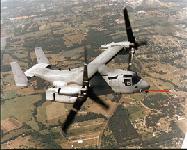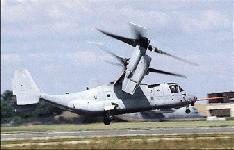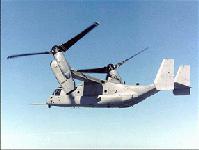

Work begins on CV-22 Osprey
Released: 10 Jun 1999

MV-22 No. 9 was delivered to Bell Textron's Arlington, Texas, facility June 7 to be re-manufactured into a CV-22, the Air Force variant of the tilt-rotor Osprey. (Photo courtesy of Bell Textron)

MV-22 No. 7 will be delivered to the Air Force for flight tests next year, after being modified to a CV-22, the Air Force variant of the tilt-rotor Osprey. (Photo courtesy of Bell Textron)

MV-22 No. 7 will be delivered to the Air Force for flight tests next year, after being modified to a CV-22, the Air Force variant of the tilt-rotor Osprey. (Photo courtesy of Bell Textron)
|
by 1st Lt. Dave Huxsoll
Aeronautical Systems Center Public Affairs
WRIGHT-PATTERSON AIR FORCE BASE, Ohio (AFPN) -- An MV-22 Osprey was delivered to Bell Helicopter Textron's Arlington, Texas, facility June 7 to be re-manufactured into the CV-22, the Air Force version of the tilt-rotor aircraft. This aircraft, a representative of future production models, will be used as a flight test vehicle.
MV-22 No. 9 is one of four engineering, manufacturing and development Marine Corps Ospreys that have been undergoing flight tests at the Naval Air Weapons Center -- Aircraft Division at Naval Air Station Patuxent River, Md. There are currently 10 Air Force managers from Aeronautical Systems Center assigned to the Navy facility, where the aircraft is being procured. These managers are supporting the procurement of 50 CV-22s for the Air Force.
"They're basically going to strip it (the MV-22) down and rebuild it to the CV-22 specifications," said Maj. Scott LeMay, CV-22 deputy program manager. "It's going to have CV-22 production wiring and all CV-22-unique systems." The Air Force is acquiring the Ospreys to replace its fleet of MH-53J Pave Low helicopters used to insert and extract special operations forces covertly from hostile areas.
The Air Force version of the Osprey will have a suite of integrated radio frequency countermeasures, which includes an active jammer. SIRFC can geo-locate threats using its missile warning receivers, as well as incorporate real-time intelligence from a multi-mission advanced tactical terminal.
"All of this information is shown to the pilot on a digital map," LeMay said. "The idea is to get in and out undetected, but if the aircraft is detected, it is very survivable. All of the critical areas will be hardened against ballistic attack, and there will be a chaff-and-flare dispense capability."
Other differences between the CV-22 and its Marine counterpart include terrain following/terrain avoidance radar, an additional 900 gallons of fuel capacity, rope ladders, a survivor locator system, and additional radios and upgraded computers.
The re-manufacture of aircraft No. 9 is scheduled for completion in May 2000. Later that summer it will enter a period of developmental testing. After completion of developmental testing in spring 2002, it will begin initial operational test and evaluation at Kirtland Air Force Base, N.M.
"We'll put it through its paces by basically doing a mock deployment," LeMay explained. "This is to make sure that it meets what's required in the operational requirements document, and that it is operationally effective and suitable."
Another EMD MV-22, No. 7, will begin being modified to the CV-22 configuration July 1. The modification is less extensive than the remanufacturing process, and will mainly involve the addition of auxiliary fuel tanks and TF/TA radar. That aircraft is scheduled for its first flight at Bell Helicopter Textron Flight Research Center, Arlington, Texas, in December. In May 2000 it will be turned over to the Air Force for developmental testing of the TF/TA radar system at Edwards AFB, Calif.
Procurement of the CV-22 is scheduled to begin in 2001, with first deliveries in 2003. The first four aircraft will go to the 58th Training Squadron at Kirtland where they will be used for CV-22 advanced aircrew training. Initial operational capability is expected in September 2004, with a squadron of six aircraft stationed at Hurlburt Field, Fla. All 50 CV-22s are scheduled to be in service by 2009.
The CV-22 Osprey is a tilt-rotor aircraft that combines the vertical takeoff, hover, and vertical landing qualities of a helicopter with the long-range, fuel efficiency and speed characteristics of a turboprop aircraft. It takes off vertically and, once airborne, the nacelles (engine and prop-rotor group) on each wing can rotate into a forward position.
The Osprey can cruise at 230 knots, and has a range three times greater than the MH-53J. It is also much quieter, thereby avoiding enemy threats. The standard CV-22 crew will consist of two pilots and a flight engineer. Current plans call for initial aircrew training to be conducted jointly at Marine Corps Air Station New River, N.C.
The Boeing Company and Bell Helicopter Textron manufacture the Osprey. Boeing will produce the fuselage and all subsystems, digital avionics, and fly-by-wire flight-control systems at its Philadelphia facility. The aircraft then will be transported by C-17 to Bell Helicopter Textron's new Amarillo, Texas, facility for the wing, transmissions, tail section, rotor systems and engine installation.
RELATED SITES
* MH-53J Pave Low
* Aeronautical Systems Center
* Edwards Air Force Base, Calif.
* Hurlburt Field, Fla.
* Kirtland Air Force Base, N.M.
* U.S. Marine Corps
* Wright-Patterson Air Force Base, Ohio




